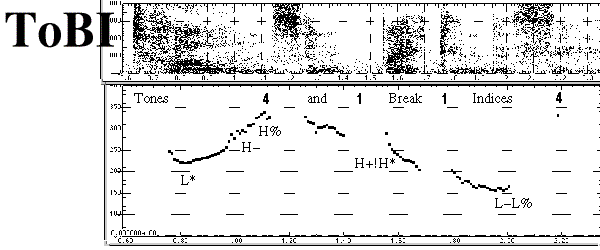
ToBI is a framework for developing community-wide conventions for transcribing the intonation and prosodic structure of spoken utterances in a language variety. A ToBI framework system for a language variety is grounded in careful research on the intonation system and the relationship between intonation and the prosodic structures of the language (e.g., tonally marked phrases and any smaller prosodic constituents that are distinctively marked by other phonological means).
|
Because a ToBI-framework system is a community-wide standard, it requires a community of users who have agreed to adopt the conventions in database development and related research. It must also conform to the following five principles:
- The conventions are as accurate as possible, given the current state of knowledge. Ideally, they will be based on a large and long-established body of research in intonational phonology, dialectology, pragmatics and discourse analysis for the language variety, but at the very least, they are based on a rigorous analysis of the intonational phonology.
- The conventions do not replace a permanent record of the speech signal with a symbolic record. An electronic recording of the transcribed utterance is an essential component of a complete ToBI framework transcription.
- The conventions are efficient. They do not waste transcriber time by requiring the transcriber to symbolically mark non-distinctive pitch rises and falls that can be extracted from the signal automatically, or anything else that could be extracted from resources such as online pronunciation dictionaries.
- The conventions are easy enough to teach that their use is not limited to a few experts to do the transcription. Therefore, there must be a freely available manual for teaching the system to new transcribers, with many recorded examples of transcribed utterances graded from easy to difficult.
- The conventions are used and maintained consistently across transcription sites. Therefore, in the course of developing a ToBI framework system, there must be rigorous tests of intertranscriber consistency, and there should be an agreed-upon center for maintaining the standard with periodic rechecks and evaluation of any proposed revisions.
Complete systems, with published standards, training materials, and intertranscriber consistency tests, have been developed for:
English covers Mainstream American, Southern British RP, Australian varieties German
standard varietyJapanese
standard (Tokyo) varietyKorean
standard (Seoul) varietyNearly complete systems, with training materials but no published intertranscriber consistency tests as of yet, have been developed for:
Greek
standard (Athens) varietyCatalan
multiple varietiesPortuguese Partially-developed systems have been described for:
Serbian English - Glasgow variety Mandarin Hong Kong Cantonese Spanish including ongoing develolpment in many varieties Taiwanese (Taiwan Min) Annotation systems with training materials in a similar autosegmental framework for intonational tunes (but without the parallel annotation of prosodic structure) are available for:
Dutch
A committee headed by Sun-Ah Jun organized a workshop on "Intonation: Models and ToBI Labeling" at ICPhS99 in San Francisco, on 1 August 1999. Prof. Jun edited a book as a result. Click here to see a preprint version of the chapter on The original ToBI system and the development of the ToBI framework that appeared in that book.
Paul Warren organized a satellite workshop Intonation in Language Varieties -- AM Approaches at the XVth ICPhS in Barcelona on Sunday, 3 August 2003, to discuss the application Autometrical-Metrical approaches to the intonation of different varieties of the same language.
Laurie Maynell and Allison Blodgett organized a ToBI Clinic that ran from January 2004 through April 2005. The web page where they posted a weekly utterance of English to be transcribed and discussed is still available.
Mary Beckman offered a Practicum on Intonation at the Ohio State University, 21 June through 20 July 2004, as part of the 2004 Summer Classes 2004 Summer Classes in Linguistics.
Nanette Veilleux, Stefanie Shattuck-Hufnagel, and Alejna Brugos held a workshop on Spontaneous Speech: Resources for prosody and ToBI-related research at Simmons College, Boston, on 13-14 August 2004.
They subsequently took over the responsibility for maintaining the original English ToBI conventions, including the organizing of a short course on AME ToBI transcription that was taught in January and February, 2006, at MIT.
Sónia Frota and Gorka Elordieta organized a workshop on "Transcription of Intonation in the Ibero-Romance Languages" as a satellite to the third biennial Phonetics and Phonology in Iberia conference in Braga on 27 June 2007.
Sun-Ah Jun organized a workshop on "Intonational Phonology: Understudied or Fieldwork Languages" at ICPhS 2007 in Saarbruecken.
Jennifer Venditti gave a short course on intonation and ToBI framework labelling at the LSA Linguistic Institute at Stanford University 1-3 July 2007.
Julia Tevis McGory gave a course on English intonation and ToBI labelling in Term 2 of Summer Quarter, 2007, at OSU.
send e-mail to tobi atsign ling.ohio-state.edu (replace the " atsign " with the atsign or remove the spaces in the e-mail link)